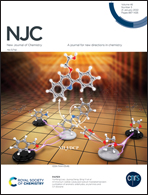Photo-controlled self-assembly behavior of novel amphiphilic polymers with a rosin-based azobenzene group†
Abstract
Novel ‘bola’ rosin-based photo-responsive amphiphilic polymers PMPn (n = 17, 34, or 69) were synthesized using poly(ethylene glycol) (PEG) as a double hydrophilic head and N-azobenzenemaleimidepimaric acid (AZOMPA) as a hydrophobic tail. The relatively fixed position of the rigid group of rosin can reduce the entanglement of PEG chains and enhance the influence of the cis-isomerization of azobenzene on the volume and polarity of the entire polymer. Consequently, all polymers with different chain lengths show an extremely high photoresponsive efficiency and various morphological changes. For the PMP17 and PMP34 assemblies, collapse of the sphere micelles takes place upon UV irradiation and this process is reversible; by contrast, the PMP69 assemblies transformed from worm micelles to large spherical micelles, cloud-like micelles, large composite micelles and irregular spherical micelles. Subsequently, encapsulation of the hydrophobic fluorescent probe Nile red and as well as its release from the loaded probes triggered by UV irradiation were evaluated. The UV irradiation experiments demonstrated the photoresponsive behavior of the “bola” amphiphilic polymers PMPn containing the rigid rosin-based azobenzene group, giving an elegant strategy for design of stimuli-responsive materials.



 Please wait while we load your content...
Please wait while we load your content...